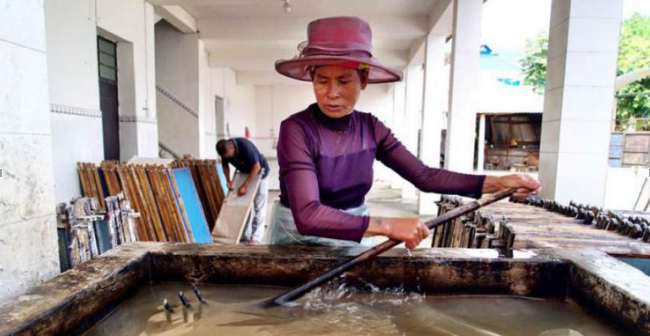
Manzhao is a small village surrounded by tropical rainforest, widely known as the “Dai paper” mill in the Dai Autonomous Prefecture of Xishuangbanna, Yunnan Province. “We’ve been making Dai paper in the village of Manzhao for over 800 years,” said Yan Kan, an inheritor of the papermaking craft. From the age of five, he saw his family using iron pots to make Dai paper. When he was 16 years old, he was taught by his grandparents to be a papermaker and was quickly able to complete the production process independently.
According to Yan Kan, the origin of the paper is related to the Buddhism in the area. In the Southern Song Dynasty (1127–1279), after the Central Plain’s paper-making technique was introduced into the village of Manzhao, the Buddhist Dai king asked the villagers to produce the paper for the Buddhist scriptures. Due to its high quality, Dai paper gradually replaced the Indian palm-leaf manuscripts and became the carrier of Dai people’s beliefs and cultural heritage.
Following Yan Kan through the village of Manzhao, we came across the rainforest. Yan Kan told us that the production of Dai paper starts from here. "Unlike ordinary papermaking that requires the cutting of trees, Dai paper is environmentally friendly because its raw material is the recyclable bark of these trees.”
Although Dai paper carries the culture and beliefs of the Dai people, it faced problems. So Yan Kan improved Dai’s papermaking technology, saving on production time and reducing labor costs, and then he started teaching his new papermaking process to the villagers for free. Due to the continuous development in papermaking technology, Dai paper is now widely used. People use it for Buddhist scriptures, tea wrapping, paper umbrellas, lanterns, hats, and even temporary rooftops. Starting from a small village in Xishuangbanna, Dai paper has now traveled to the United States, Thailand, Japan, South Korea and other parts of the world.
本时文内容由奇速英语国际教育研究院原创编写,未经书面授权,禁止复制和任何商 业用途,版权所有,侵权必究!(投稿及合作联系:微信:13350077298 QQ:757722345)
1.Why did Yan Kan become an inheritor of the papermaking craft?
A His village was surrounded by tropical rainforest.
B He lived where people called the “Dai paper” mill.
C He was born in a family that could make the paper.
D He went to learn paper-making technique in India.
解析:选C。推理判断题。根据第一段最后两句From the age of five, he saw his family using iron pots to make Dai paper. When he was 16 years old, he was taught by his grandparents to be a papermaker and was quickly able to complete the production process independently.可知他的家庭就是造纸的,因此他才能成为造纸术的传承人,故选C。
2.What did people use when they copied the scriptures before Dai paper?
A The iron pots.
B The Indian palm-leaf.
C The bark of the trees.
D The paper umbrellas.
解析:选B。细节理解题。根据第二段最后一句的Due to its high quality, Dai paper gradually replaced the Indian palm-leaf manuscripts可知在傣纸发明前那里的人用palm-leaf(棕榈叶)来誊抄经文,故选B。
3.Why is the production of Dai paper environmentally friendly?
A It doesn’t need water at all.
B It requires only a few trees.
C It uses recyclable materials.
D It carries Dai people’s beliefs.
解析:选C。细节理解题。根据第三段最后一句Dai paper is environmentally friendly because its raw material is the recyclable bark of these trees可知傣纸之所以被认为环保是因为其所用的原材料是可以循环利用的树皮,故选C。
4.Why did Yan Kan improve Dai’s papermaking technology?
A It could only be used for scriptures.
B It could only be bought in China.
C It was only made in small villages.
D It needed much money to pay for workers.
解析:选D。推理判断题。根据最后一段第二句的Yan Kan improved Dai’s papermaking technology, saving on production time and reducing labor costs可知原来的造纸方法耗时,且人工成本太高,因此他改进了造纸术,故选D。